Features
Before the opening, the station name was Shinmyeong Station, and at the beginning of the opening, the Gimhae City Hall tried to change the station name to Samgye Station and Gaya University Entrance, but it was abandoned. In the beginning, the location of Gaya University was going to be located at the point where Gaya-ro and Haebancheon-ro meet, that is, across the street from Shinmyeong Elementary School and Dongwon Apt. As a result, the apartments in Buyeong Complex 2 and Hwajeong Village Apartment Complex became close to each other, and the apartment complex 5 and Prugio Apartment Complex and Ian Apartment Complex became farther away. It can be seen by looking at the distance between stations that the reverse position change seems to be anomalous. For example, the distance between Gimhae National Museum station and Yeonji Park station is about 1100m, and the distance between Yeonji Park Station and Presbyterian University Station is about 1200m, while the distance between Presbyterian University and Kaya University station has been reduced from 1150m, originally planned to 850m. In addition, because of the circulation line of the vehicle base, if it is not a stationary train in Sasang station, the next day's trains will change and operate.

Busan, officially Busan Metropolitan City, is South Korea's second most populous city after Seoul, with a population of over 3.3 million inhabitants as of 2024. Formerly romanized as Pusan, it is the economic, cultural and educational center of southeastern South Korea, with its port being South Korea's busiest and the sixth-busiest in the world. The surrounding "Southeastern Maritime Industrial Region" is South Korea's largest industrial area. The large volumes of port traffic and urban population in excess of 1 million make Busan a Large-Port metropolis using the Southampton System of Port-City classification. As of 2019, Busan Port is the primary port in Korea and the world's sixth-largest container port.

Gimhae International Airport is located on the western end of Busan, South Korea. Opened in 1976, the airport is named after the nearby city of Gimhae. A new international terminal opened on October 31, 2007. Gimhae International Airport is the main hub for Air Busan, and a focus city for Jeju Air, Jin Air and Korean Air. Runway 18L/36R is used for military purposes only for Gimhae Air Base, but due to increasing traffic, there are plans to open the runway for airliners. In 2018, 17,064,613 passengers used the airport.

South Gyeongsang Province is a province in the southeast of South Korea. The provincial capital is at Changwon. It is adjacent to the major metropolitan center and port of Busan. The UNESCO World Heritage Site Haeinsa, a Buddhist temple that houses the Tripitaka Koreana and tourist attraction, is located in this province. Automobile and petrochemical factories are largely concentrated along the southern part of the province, extending from Ulsan through Busan, Changwon, and Jinju.

Geumgwan Gaya (43–532), also known as Bon-Gaya or Garakguk, was the ruling city-state of the Gaya confederacy during the Three Kingdoms period in Korea. It is believed to have been located around the modern-day city of Gimhae, Southern Gyeongsang province, near the mouth of the Nakdong River. Due to its geographic location, this kingdom played a dominant role in the regional affairs from the Byeonhan period onward to the end of the Gaya confederacy.
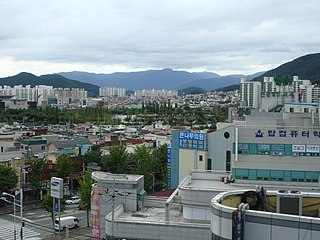
Gimhae is a city in South Gyeongsang Province, South Korea, situated near the Nakdong River.

Suro (수로) or Sureung, commonly called Kim Suro, was the legendary founder and Hero King of Geumgwan Gaya (43–532), in southeastern Korea.
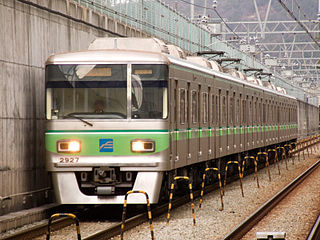
The Busan Metro is the urban rail system operated by the Busan Transportation Corporation of Busan, South Korea. The metro network first opened in 1985 with seventeen stations, making Busan the second city in South Korea and third in the Korean Peninsula to have a metro system. The Metro itself consists of 4 numbered lines, covering 116.5 kilometres (72.4 mi) of route and serving 114 stations. Including the BGL and the Donghae Line, the network covers 205.6 kilometres (127.8 mi) of route and serving 158 stations.
City Hall Station or City Hall station may refer to:

The Busan–Gimhae Light Rail Transit is a light metro system between the cities of Busan and Gimhae in South Korea. The line has 21 stations including Daejeo and Sasang where passengers can transfer to Busan Metro Line 3 and Line 2 respectively. The line thus acts as a connecting rail between both Gimhae and Busan International Airport with two western outreaches of the Busan Metro system.

Daejeo Station is a station of the Busan Metro Line 3 and BGLRT Line located in Daejeo-dong, Gangseo District, Busan, South Korea. It is a southern terminus of Line 3 at this station. During the construction, the Line 3 Station was known as Jungni Station, and Busan-Gimhae Light Rail Station known as Seoyeonjeong Station.

Gimhae International Airport Station is a station of the BGLRT Line of Busan Metro in Daejeo-dong, Gangseo District, Busan, South Korea.
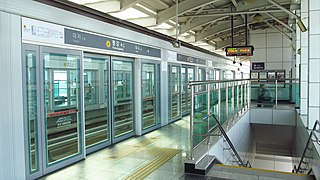
Pyeonggang Station is a station of the BGLRT Line of Busan Metro. The station name comes from the nearest Pyeonggang-ro. The station is located at Daejeo-dong, Gangseo District, Busan, South Korea.

Buram Station is a station of the BGLRT Line of Busan Metro in Buram-dong, Gimhae, South Korea.

Jinae Station (Korean: 지내역) is a station of the BGLRT Line of Busan Metro in Jinae-dong, Gimhae, South Korea.
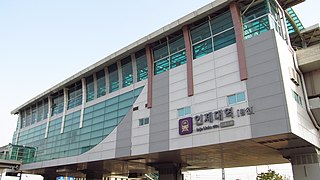
Inje University Station is a station of the BGLRT Line of Busan Metro in Samjeong-dong, Gimhae, South Korea.

Buwon Station is a station of the BGLRT Line of Busan Metro in Buwon-dong, Gimhae, South Korea.

Bonghwang Station is a station of the BGLRT Line of Busan Metro in Jeonha-dong, Gimhae, South Korea. The station is located at the riverside.
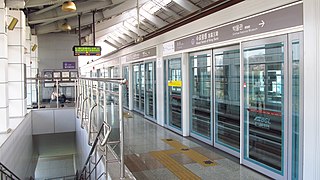
Royal Tomb of King Suro Station is a station of the BGLRT Line of Busan Metro in Oe-dong, Gimhae, South Korea.

Yeonji Park Station is a station of the BGLRT Line of Busan Metro in Gusan-dong, Gimhae, South Korea. The station name comes from Yeonji Park where the station is nearby.

Presbyterian Univ. Station is a station of the BGLRT Line of Busan Metro in Samgye-dong, Gimhae, South Korea. The station name comes from Busan Presbyterian University located at 900 meters from this station. At this station, there are no direct city bus routes.




















